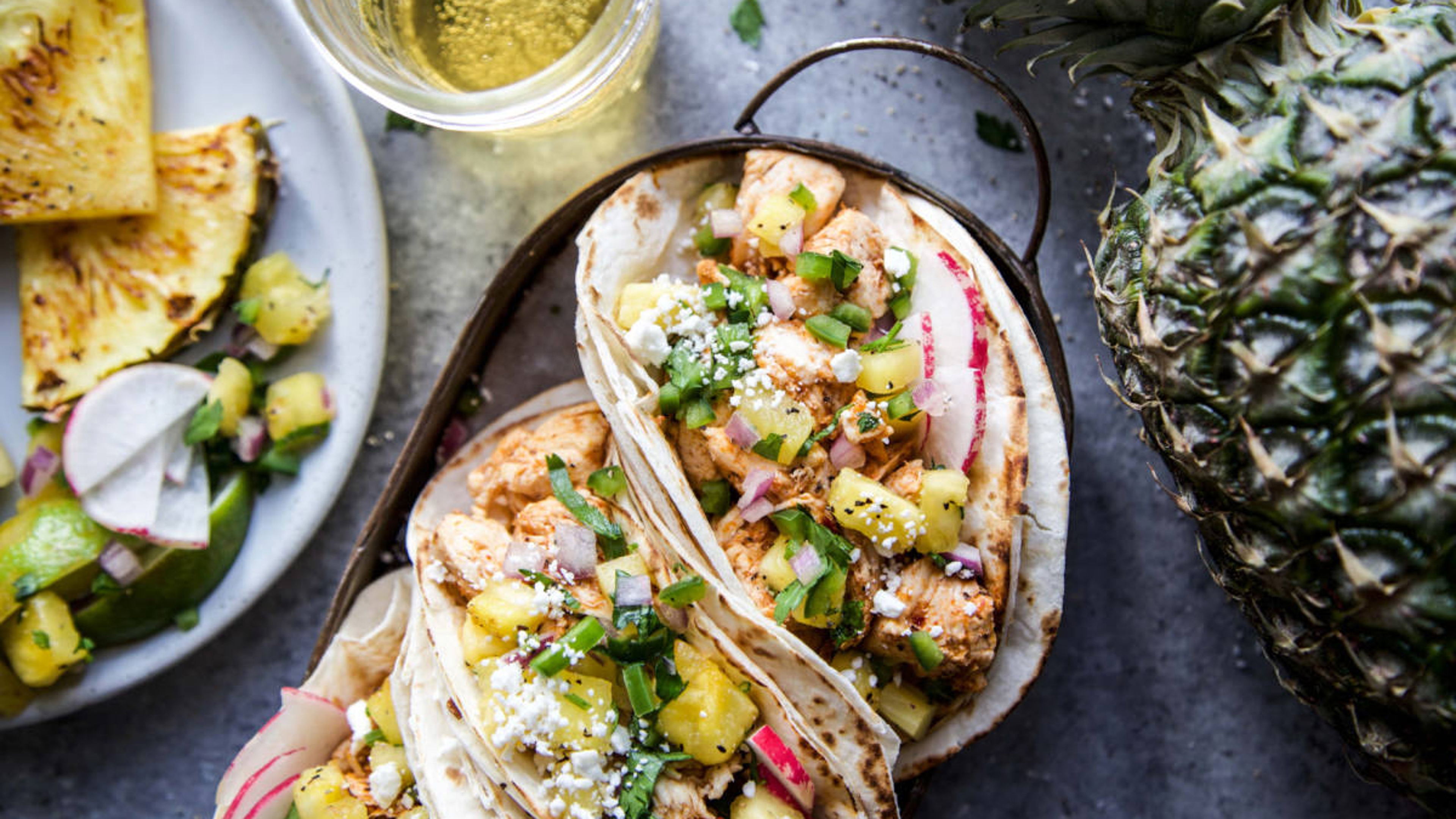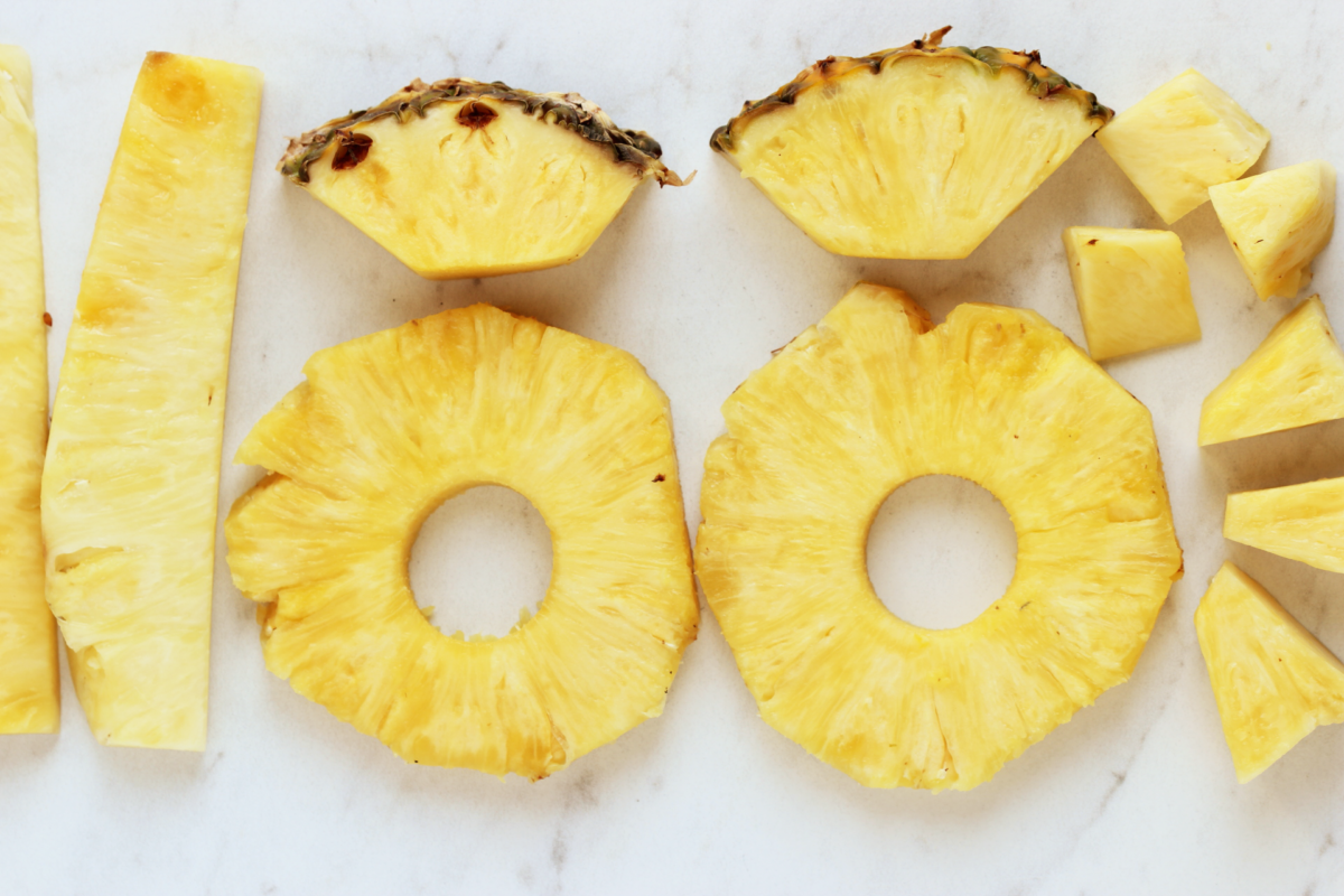A Not-so-Short Guide to the Pineapple
Hop aboard the pineapple express for one juicy, sweet fruit.
Mar 04, 2025
Pineapple may have started out as an exotic treat for the rich, but fast forward a few hundred years and this tropical delicacy has become an indulgent staple enjoyed by the masses worldwide.
Whether you eat yours fresh, diced up in salads, grilled, on a skewer, pureed in a smoothie, or served up stir-fry style, there's no wrong way to experience the explosion of sweet, tart, and tangy goodness hiding behind that spiny exterior.
Here is all the information about the pineapple worth devouring.
Scientific name: Ananas comosus
Family of fruit: Bromeliaceae
Birthplace: South America, specifically the region where Brazil, Paraguay, and northern Argentina meet.
How the pineapple got its name
The fruit's common name comes from a combination of how European explorers thought it looked and tasted: “pine," for its rough exterior similar to that of a pinecone (“pine" translates to "piña" in Spanish), plus “apple," for the fruit's sweet, juicy, “apple-like" interior.
When pineapple are in season
While pineapples are imported into the United States year-round, the peak growing season tends to be April through June. According to Jane Hunts, merchandise manager for fruit at Harry & David, this is also when Harry & David offers their absolute best.
“All of our pineapples come from a single farm in Costa Rica," Hunts explains. “The growers time their planting and pollination so our pineapples will ripen right when we need them." And unlike many of the pineapples that end up sitting in distribution centers for weeks after harvest, Hunts adds "our fruit, that comes from Costa Rica, often arrives at our packing house within just a couple days of being picked, ensuring peak ripeness and flavor."
Hit the Brix
Produce growers use a high-tech measurement called a Brix level to see how much sugar is in the fruit they grow. In short, the process involves shining light through a sample of fruit juice to see how it bends. The greater the sugar in the sample, the more the light refracts — and the higher its Brix level is overall. For example, most tomatoes come in with a Brix reading of 3 to 4, watermelon averages 9 to 11, and sweet corn tops the Brix scale with averages in the 15 to 20 range.
“We like our pineapple to have high, sweet Brix readings of 12 to 14," Hunts explains. “Our packing house tests these levels to make sure the fruit meets our standards. We reject about 30% of all the pineapples that are delivered to us — that fruit ends up in grocery stores."

Types of pineapples
More than three dozen different types of pineapples are grown around the world, each with its own unique size, flavor, and appearance. The most popular include:
Abacaxi
Tall and spiny with exceptionally sweet, virtually translucent flesh. Sadly, they are very delicate and hard to ship far distances.
Brecheche
These small, olive-tinted, cylinder-shaped fruit are one of the few pineapples that are completely spike-free.
Kona Sugarloaf
A cousin of the Smooth Cayenne (see below), Kona Sugarloafs are beloved for their lack of acidity, high sugar content, and a core that you can eat.
Pernambuco
Brazil's favorite pineapple, the Pernambuco has a mild delicate flavor and sports pale yellowish-white flesh and long, distinctive spiny leaves.
Queen
Most commonly sold in Australia and South Africa, these cold-tolerant fruits are typically dark yellow with a very fine, dense core.
Red Spanish
A Caribbean staple, these sturdy, highly aromatic fruits get their name from their unusual orangish-red skin.
Singapore Red
Outside, these small fruits have a unique reddish color (including a red stripe on the tips of their leaves). Inside, they are golden-yellow with crisp, tangy flesh that makes them ideal for canning.
Smooth Cayenne
The type of pineapple we see most often in U.S. markets, Smooth Cayennes tend to be larger and juicier than other pineapple and are typically imported from Hawaii.
Anatomy of a pineapple
The pineapple is a true sight to behold, looking a bit like a tropical cactus that T-Rex might have sniffed around at. Imposing in person, the plants can live for up to 20 years and can grow to more than 5 feet tall. Still, despite their size, each plant is only able to produce a single pineapple each year!
Inflorescence
Each pineapple starts as a cluster of up to 200 vibrant, pointy flowers (called an inflorescence) that grow from the center of the plant. “After they are pollinated, these flowers slowly fuse together to become the pineapple fruit," Hunts explains. “It's a fascinating process. Once you know how the fruit forms, you can really see the structure of how it comes together when you cut it open."
Suckers
These tiny offshoots, or baby pineapple runners, branch out from the parent as it grows to form new plants.
Leaves
Long, thin, and waxy (to reduce water loss), the pineapple plant's thick, fibrous leaves grow in a symmetrical pattern around the stem.
Stem
Composed of overlapping leaves that fuse together as the plant grows, the central stem on a pineapple needs to be especially tenuous and strong, capable of supporting fruit that can weigh more than 10 pounds.

Core
A continuation of the plant's stem running directly through the center of the pineapple fruit, the core is tough, stringy, and difficult to chew due to the fact that the region previously supported the inflorescence as it grew.
Skin
The outer exterior of the pineapple is rough and spiky on purpose — do not eat it. Experts believe its development may have been an evolutionary tactic to help protect the juicy flesh inside the fruit from animal predators.
Crown
This is the leafy top of the pineapple plant that remains on the fruit after it is harvested. You can grow a new pineapple plant by saving the crown and placing it in water until roots develop, and then planting the fledgling pineapple in rich soil and watering it regularly.
Eyes
These small, dark spots located on the surface of the fruit are where the fruit's flowers used to be located. Each eye contains a small, undeveloped flower that failed to fully mature as the pineapple was forming. They're safe to eat, but most people avoid them.
5 steps to prepping a pineapple
1. Select the right fruit
“Pick pineapples that are slightly soft to the touch and are yellow," suggests Elizabeth Ward, a Massachusetts-based registered dietitian, writer, and nutrition consultant. “Pineapple is one of the few fruits that stops ripening once it is harvested," Hunts adds. “The fruit will become softer, but it will not ripen." Avoid any with brown spots or bruises.
2. Trim It
Remove the top and bottom of the pineapple with a sharp knife.
3. Peel it
Stand the pineapple upright and cut off the skin using a downward motion. Be sure to also remove all those brown "eyes" from the fruit as you peel.
4. Core it
Slice the peeled pineapple into quarters, lengthwise. Remove the core from each quarter with a diagonal cut.
5. Slice it, dice it, and enjoy it
“Serve the pineapple immediately, or store it in an airtight container in the fridge for up to five days," Hunts advises.
Power of the pineapple
It may be sweet as candy, but pineapple is high in fiber and packed with nutrients, while still coming in at a relatively lean 82 calories per cup when eaten raw.
“One cup of pineapple is an excellent source of vitamin C and the mineral manganese, and contains potassium, copper, and antioxidants, too," says Ward. “Pineapple also provides bromelain, a group of enzymes that may have anti-inflammatory effects," she adds.
By reducing levels of inflammation in the body, eating pineapple regularly may help to ward off cancer and heart disease, reduce premature signs of aging, and even improve sleep quality and athletic performance.
5 surprising facts about pineapple
- Because they were so difficult and costly to import, pineapples were for centuries considered a symbol of wealth and hospitality.
- The juice from a pineapple is a natural meat tenderizer and ideal for use as a marinade.
- Pineapple has a long history in medical folklore, serving as a natural cure for coughs and sore throats.
- Pineapples are a symbol of good luck and prosperity in Chinese feng shui. In some dialects, the word "pineapple" even sounds similar to a popular phrase meaning “Good luck is coming your way."
- When texting, a pineapple emoji is often used to mean that you are in a complicated relationship, where things might be “prickly."
Our favorite pineapple recipes
Whether it's the main ingredient or tossed in a salad, cooking with pineapple adds a burst of flavor to every dish. These are our favorite pineapple recipes.
Escape with a piña colada
Is there any better drink to imbibe while sitting poolside and catching some rays in the tropics (or even just thinking about them) than a piña colada? Maybe that's why this cocktail made with fresh pineapple juice is the official drink of Puerto Rico. The piña colada was created in 1954 by Ramón “Monchito" Marrero, a bartender at the Beachcomber Bar at the Caribe Hilton Hotel in San Juan. However, like so many other food and drink origins, there are disputing stories...

If you want to make a classic piña colada and escape (like the song says) to the Caribbean, simply blend 2 ounces of white rum, 1 ounce of coconut cream, 1 ounce of heavy cream, and 6 ounces of fresh pineapple juice. Then, add a half cup of crushed ice and blend until smooth, for about 15 seconds. Serve in a 12-ounce glass. Garnish with a fresh pineapple wedge and maraschino cherry. Happy sipping!
.svg?q=70&width=384&auto=webp)





















